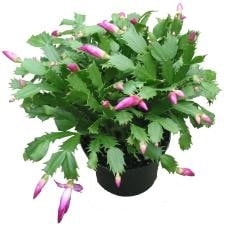 The Christmas Cactus is a beautiful blooming plant we love to have in our homes during the Christmas months. These plants have tubular papery blooms with reflexed petals that occur at the ends of flat segmented (chainlike) succulent stems. When mature, the stems form arching branches. Christmas cacti have smooth stem edges. Here are a few tips to help keep your plant looking great!
The Christmas Cactus is a beautiful blooming plant we love to have in our homes during the Christmas months. These plants have tubular papery blooms with reflexed petals that occur at the ends of flat segmented (chainlike) succulent stems. When mature, the stems form arching branches. Christmas cacti have smooth stem edges. Here are a few tips to help keep your plant looking great!
The Christmas Cactus is also knows as the Schlumbergera spp. and formerly Epiphyllum and Zygocactus.
In ideal environments and with proper care, these plants can flower for three to seven weeks. Individual blooms typically last five to eight days each and should be removed when they fade.
Light
These cacti need bright but filtered light. Exposure to direct sunlight can cause stem segments to turn reddish (sunburn).
Water
Keep potting medium consistently moist; water when the compost begins to dry out. Avoid underwatering and overwatering (see “Challenges: Diseases”). If water is extremely hard, use rainwater.
Temperature
Cool to average room temperatures—55 F to 70 F— are preferred while plants are in bloom.
Humidity
Indoors, these plants like moderately humid environments. Mist stems regularly if plants are in warm, dry rooms, but avoid getting blooms wet.
Care Extras
Avoid moving plants often; doing so can cause them to drop their buds and blooms. Leave plants in one location as much as possible, and advise customers to do the same.
Fun Facts about the Christmas Cactus
WHAT’S IN A NAME It is generally thought that the genus name Schlumbergera was given in honor of Frédéric Schlumberger (1823–1893), a French horticulturist who collected cacti. Some sources, though, suggest the genus is named after Frederick Schlumberger (1804–1865), a Belgian horticulturist and plant collector. The former genus name Zygocactus is often used now as a common name for these plants.
ALL IN THE FAMILY Schlumbergera is a member of the Cactaceae (cactus) family, which includes both forest-type cacti, like these plants, as well as desert-type cacti. Unlike desert cacti, forest cacti are indigenous to woodlands, tropical jungles and rain forests. They are epiphytes (air plants) that grow nonparasitically on other plants or elevated supports, obtaining water and nutrients from the air through their roots.
HOME SWEET HOME These plants are native to the coastal mountain regions of southeastern Brazil
Information source: Super Floral Retailing
